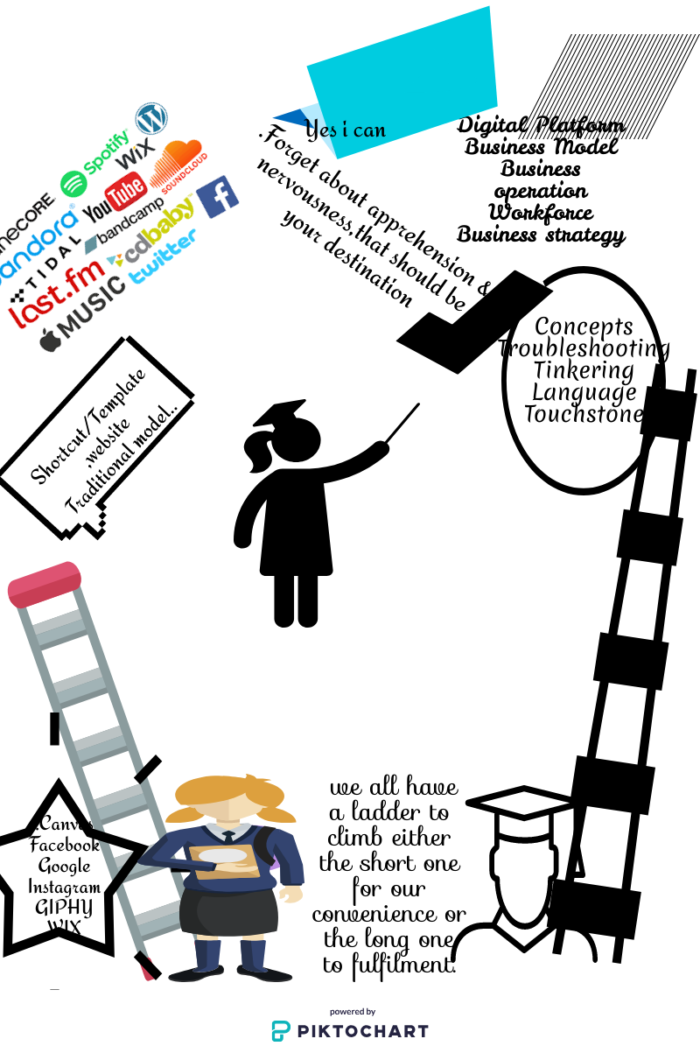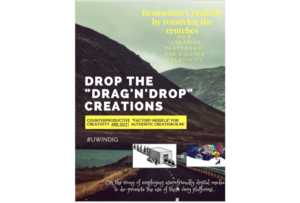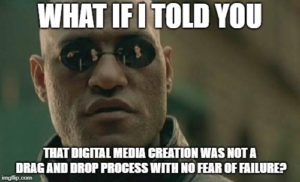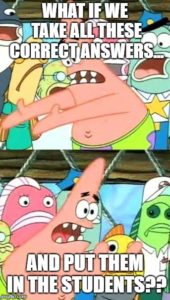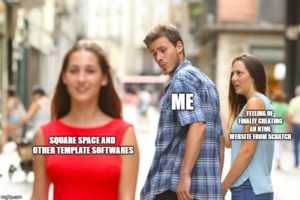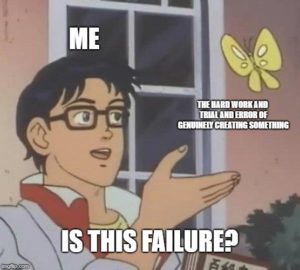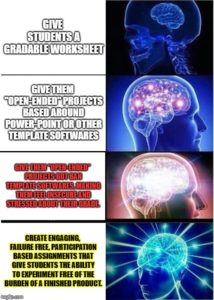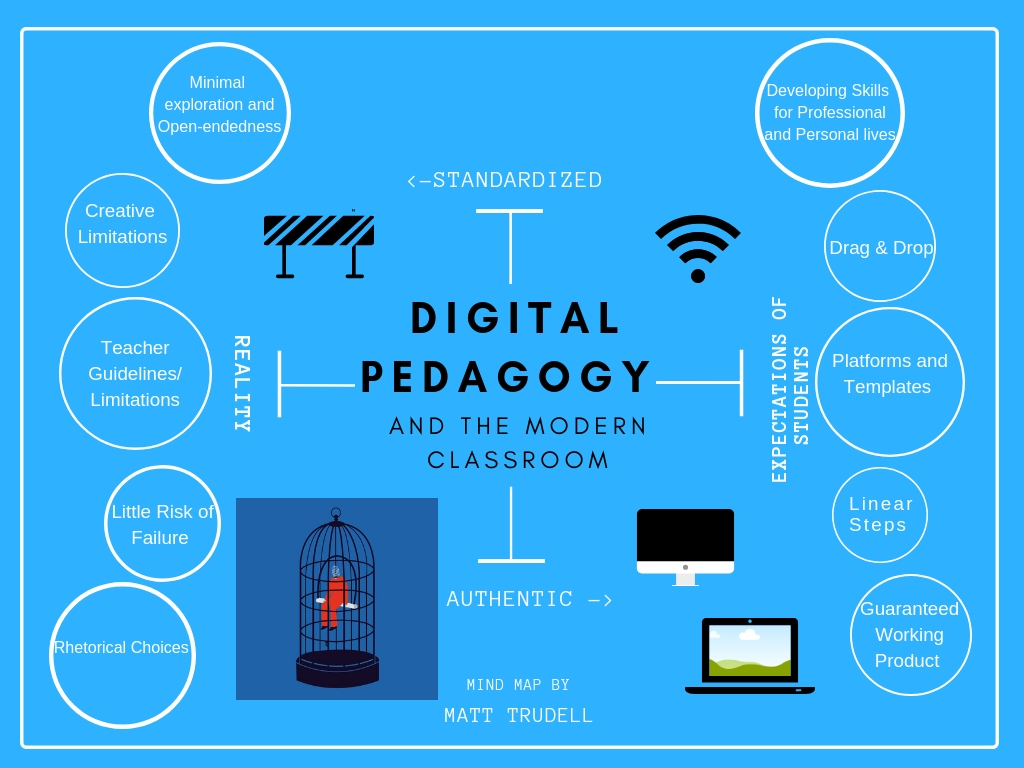Throughout history, we have seen new technologies and innovations that have revolutionized our everyday lives. The invention of the cellular telephone in 1973 has changed the way we communicate, and with the advancement in smartphone technology, we have access to a vast wealth of information through a device that fits into the palm of our hand. What is considered one of the most incredible inventions in modern history, however, has created a massive fissure in an already problematic educational system.
The article, ‘Tackling Tech: How some Ontario teachers are attempting to limit students’ cellphone use’ looks at how an Ontario High School began using individualized pouches (specifically Yondr pouches in this case) students can store their devices in while in the classroom as a means to limit distractions and curb use. According to the article, teachers have seen the method of these pouches have proven to be more effective at curbing cell phone use than a total ban. already noticed an increase in the grade point averages for the classes using these pouches. An obvious observation, by students not having access to their phones during instruction time, they are much more attentive, engaged and less distracted. The result; a deeper understanding of the classroom material and better grades.
and better grades.
Teachers argue both sides. There are those that see the positive aspects as a result of devices in the classroom, like how manipulating technology efficiently and effectively can enrich and deepen their learning with a growth mindset, as much as it can improve their learning experience. Also, there are those that think we should ban cellphones completely, saying cell phones are nothing but a constant distraction from the lesson at hand and make it near impossible for the teacher to maintain control of the classroom and ensure students are paying attention.
It is not surprising to hear that many schools who have implemented ways of limiting use in the classroom without an outright ban are seeing increases in grade point averages. At the beginning of the academic year, France implemented a complete ban on mobile phones on school property in an attempt to maximize learning time. To me, this seems extreme, however I can see how it could benefit the school, the students, and the community culture as well. Many schools are allowing teachers to create their own regulations based on their teaching philosophy, putting in place rules that align well with their classroom and the environment they have created. I feel as though this approach affords educators that flexibility and students some variability from year to year or classroom to classroom.
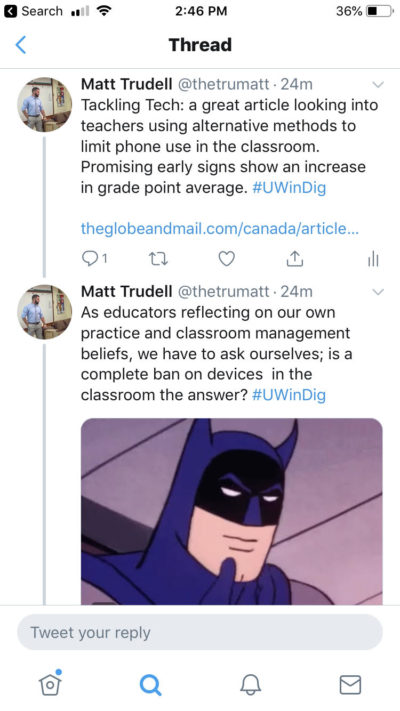
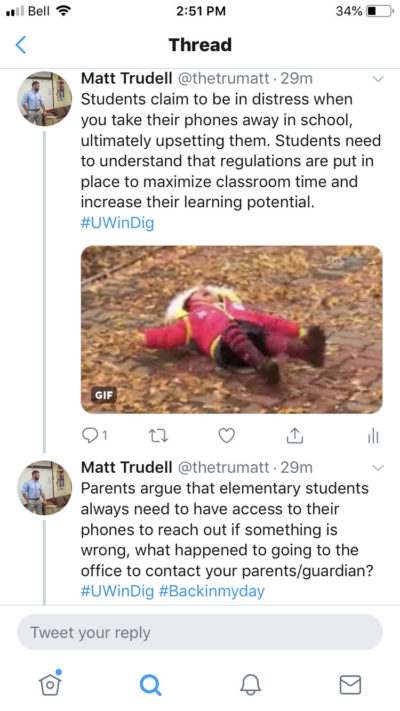
A common issue I have seen when students late in elementary school years (grades 7 & 8) have unlimited access, is the ability for students to bully other students and go undetected by teachers or other adults. This can go on for a long time, while students can harass and bully other students without any means of discipline. I had a grade 8 student who came to me after a few weeks of being quiet and reserved. I asked him if anything was going on or if he wanted to talk about anything at all. As it turns out, this student was being bullied on Twitter, Facebook, Instagram and snapchat for the last few weeks after a picture was posted from another student in the class, where this male student looked like they had their hand near another male student’s genitals. Of course, after analyzing the picture it was clear the student was not making contact but was caught in an unfortunate pose. After bringing this up to my Associate Teacher and the Administration, an investigation into the bullying of the student took place. Those responsible received in-school suspensions. After this, the school continued to operate under their ‘bring-your-own-device’ policy that had in place prior to the incident. Students always had access to their devices; in classrooms, halls and the yard. I found instructing to be extremely difficult. In this eighth grade class, I had to continually ask students to put their phones away, most of the time texting or sharing inappropriate content with other students.
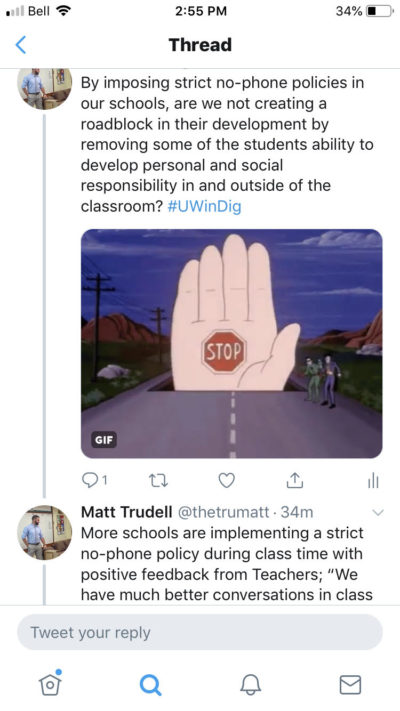
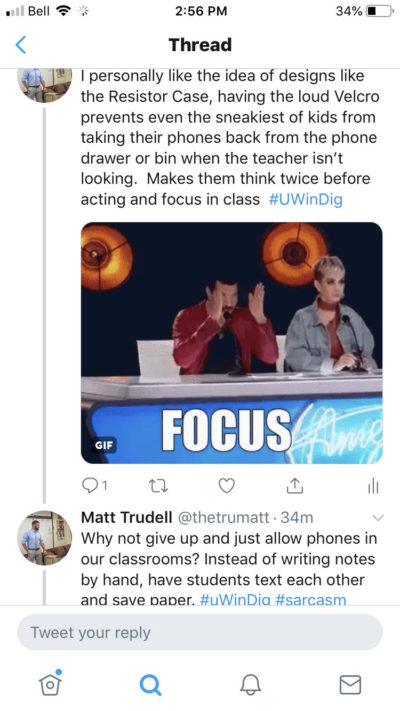
Prior to looking at the article, I felt very strongly that students should not have their cellphones in the classroom at all. Upon hearing the alternative approaches to limiting use, I feel as though there should be no out right ban, but the decision on restricting use remains with the teacher. This is partially due to my own experience in my teaching placements and past supply teaching, as well as the data that clearly shows an increase in student performance and grade point average as soon as devices like the Yondr or The Resistor Case (are implemented in the classroom. I am a particular fan of the Resistor Case as their site offers a step-by-step guide on how to build your own simple version of the case as well as the option to buy one of their completed units. Reflecting on my own views, this article has helped fortify my beliefs about restricting cellphone use in the classroom. Even though cellphones can be great learning manipulatives for various applications and functions, the reality is that many students (especially in the elementary system) lack the maturity and discipline to stay focused in the classroom with their device at their fingertips. Albeit, I haven’t had any experience at the high school level. At this point, I feel like we need to embrace digital devices, as the students need to develop the right self-regulation habits that will prepare them to enter the workforce and understand when and when not to be using your device.
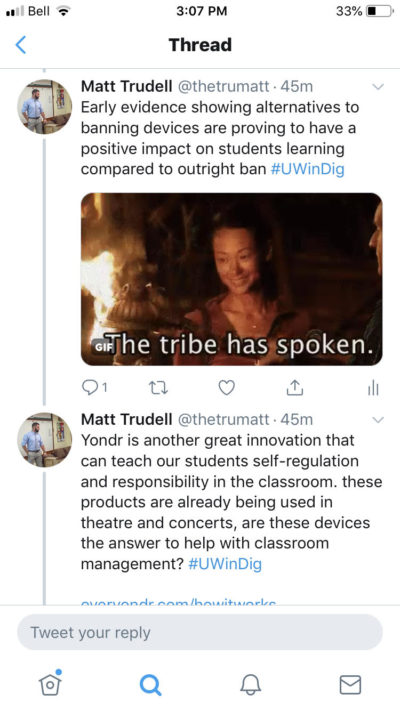

Look at the adults around you… we have all become completely absorbed by our devices.  I know I was appalled when the Screen time application was installed on my IPhone. If we don’t restrict children’s use of cellphones at the elementary level for at least some duration of the day, while many of them have no time limits at home, how dependent will this generation be on their devices when entering the work force? Looking back, this is part of the reason I felt like a ban was necessary to begin with; we are becoming too reliant on our devices, however, by implementing self-regulation methods and giving the students a chance to be instrumental in their own learning, we can assure the next generation of youth are prepared and cognizant of their use of devices.
I know I was appalled when the Screen time application was installed on my IPhone. If we don’t restrict children’s use of cellphones at the elementary level for at least some duration of the day, while many of them have no time limits at home, how dependent will this generation be on their devices when entering the work force? Looking back, this is part of the reason I felt like a ban was necessary to begin with; we are becoming too reliant on our devices, however, by implementing self-regulation methods and giving the students a chance to be instrumental in their own learning, we can assure the next generation of youth are prepared and cognizant of their use of devices.
– Matt
#UWinDig

 rivate information from the hospital and use it against you, now it’s about hacking the database and changing the blood type to kill you. He simply states the internet is coming, and it isn’t all it’s hyped up to be. A casino in vegas was hacked through an internet connected fish tank (and to me that sounds unheard of). Schneier explains that we can longer afford to make products in which systems and the government can spy on us, because the “bad guys” are using the same route to take things over. One day we will wake up with a hacked thermostat and be forced to pay in order to reclaim our houses. Schneier ends with the point that the government needs to put defense before offence. Companies need to ensure that systems are secure, rather than keep systems vulnerable for threats in order to attack against said threat. It’s out of our hands… companies need to change, and the government needs to change in order to secure safety.
rivate information from the hospital and use it against you, now it’s about hacking the database and changing the blood type to kill you. He simply states the internet is coming, and it isn’t all it’s hyped up to be. A casino in vegas was hacked through an internet connected fish tank (and to me that sounds unheard of). Schneier explains that we can longer afford to make products in which systems and the government can spy on us, because the “bad guys” are using the same route to take things over. One day we will wake up with a hacked thermostat and be forced to pay in order to reclaim our houses. Schneier ends with the point that the government needs to put defense before offence. Companies need to ensure that systems are secure, rather than keep systems vulnerable for threats in order to attack against said threat. It’s out of our hands… companies need to change, and the government needs to change in order to secure safety.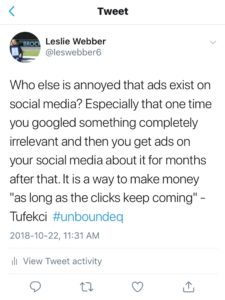 While I was listening to this podcast, the thought came to me that this directly relates to the twitter hashtag #unboundeq that we’ve recently had in this class. All of thetopics that Bruce Schneier was talking about was basically the class discussion we had on twitter. The internet is all around us and it’s scary how often someone is listening to us, especially when it comes to our personalized ads on Facebook.
While I was listening to this podcast, the thought came to me that this directly relates to the twitter hashtag #unboundeq that we’ve recently had in this class. All of thetopics that Bruce Schneier was talking about was basically the class discussion we had on twitter. The internet is all around us and it’s scary how often someone is listening to us, especially when it comes to our personalized ads on Facebook.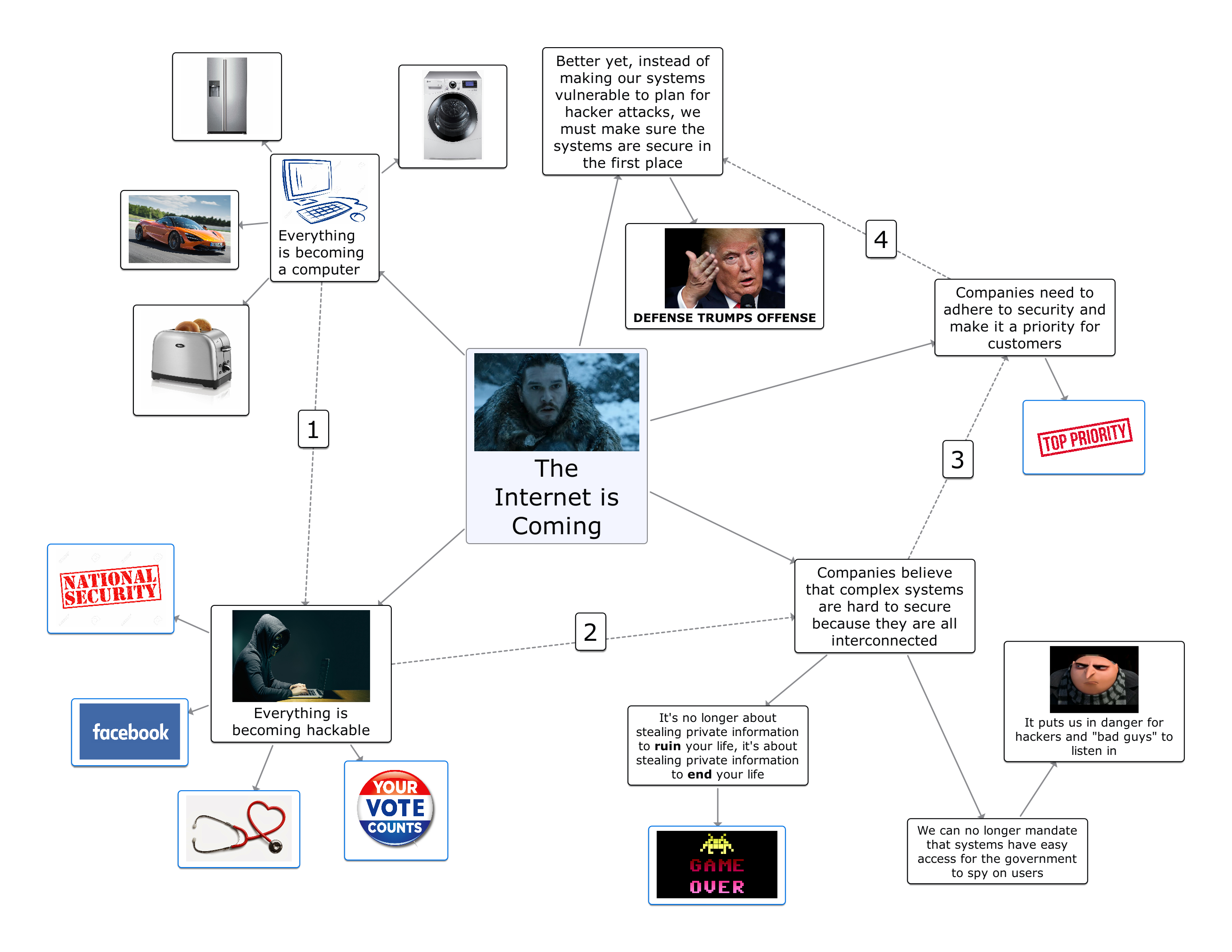
 The internet used to just be about data, when our data was stolen and abused it was more of an unfortunate inconvenience but now the internet has access to things that can actually harm us and this presents a real risk to our well-being. Schneier explains the only way for companies to improve the security on their products is for the government to step in and force them to. Without an order from the government the only thing these companies are concerned with is making a profit off ill-informed consumers who are not even thinking about the security risks of purchasing a new refrigerator.
The internet used to just be about data, when our data was stolen and abused it was more of an unfortunate inconvenience but now the internet has access to things that can actually harm us and this presents a real risk to our well-being. Schneier explains the only way for companies to improve the security on their products is for the government to step in and force them to. Without an order from the government the only thing these companies are concerned with is making a profit off ill-informed consumers who are not even thinking about the security risks of purchasing a new refrigerator. educate students about the risks that come along with all the technology they are being exposed to. Does their home really need to be connected to their phones? With the thermostat, lights, TV and security system accessed through an app we are essentially inviting strangers into our homes because of convenience. Instead of remembering to turn off the lights we can just do it from the car on our morning commute. Educating students about what is available to them in terms of technology as well as the risks that go along with it will allow them to think critically about the risks they are opening themselves up to. Hopefully safety and security of citizens in the technical world will soon become the government’s first priority but until it is, as a future educator I will make sure to give my students the tools they need to protect themselves.
educate students about the risks that come along with all the technology they are being exposed to. Does their home really need to be connected to their phones? With the thermostat, lights, TV and security system accessed through an app we are essentially inviting strangers into our homes because of convenience. Instead of remembering to turn off the lights we can just do it from the car on our morning commute. Educating students about what is available to them in terms of technology as well as the risks that go along with it will allow them to think critically about the risks they are opening themselves up to. Hopefully safety and security of citizens in the technical world will soon become the government’s first priority but until it is, as a future educator I will make sure to give my students the tools they need to protect themselves.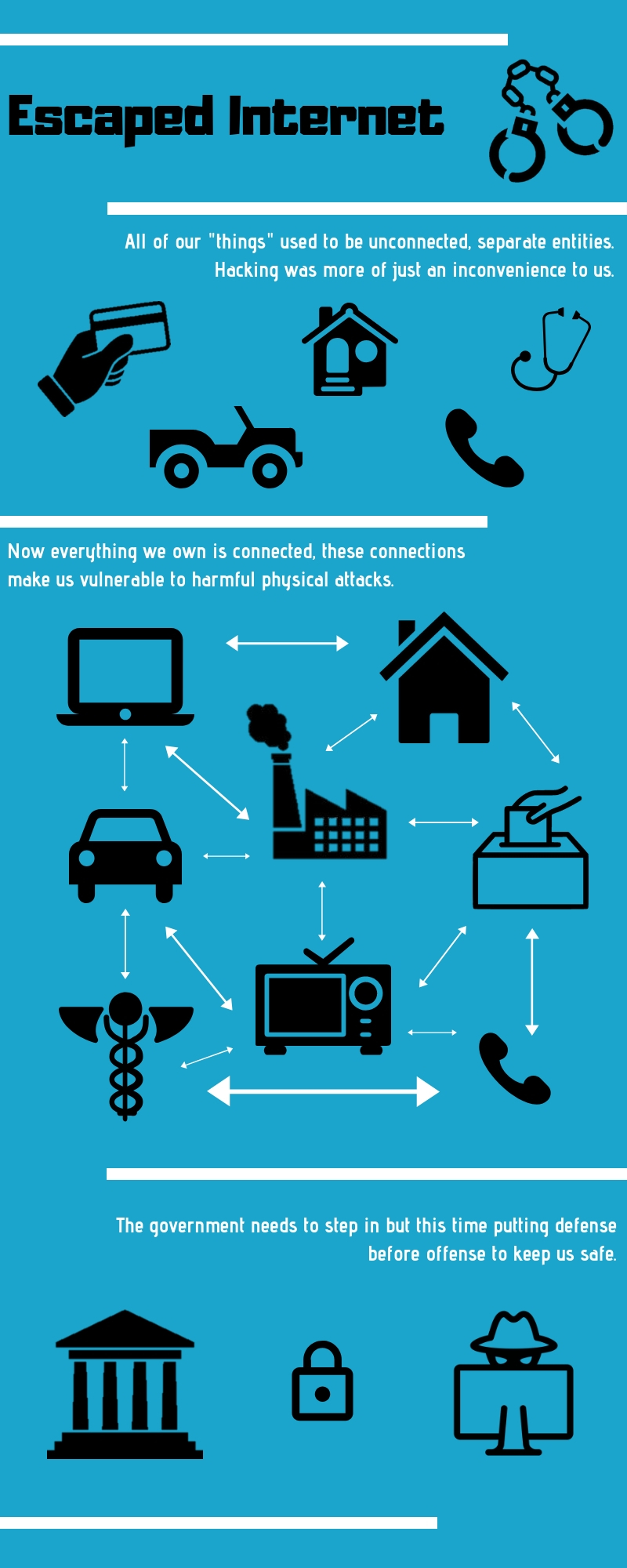
 read “
read “ vior-tracking app that awards students points or subtract them based on their conduct. Many teachers say the app helps them automate the task of recording classroom conduct, as well as allowing them to communicate directly with parents. There’s a big divide when it comes to this app. Some like being able to use the app to follow their child’s progress and receive reports from teachers. Others are asking the teacher to remove his/her child from ClassDojo because they are unsure how the information is being stored/used and feel that it can create labels that are unwanted. Co-founder Mr. Chaudhary says he and his team have studied ClassDojo’s effectiveness by visiting classrooms and conversing with many teachers that have used it.
vior-tracking app that awards students points or subtract them based on their conduct. Many teachers say the app helps them automate the task of recording classroom conduct, as well as allowing them to communicate directly with parents. There’s a big divide when it comes to this app. Some like being able to use the app to follow their child’s progress and receive reports from teachers. Others are asking the teacher to remove his/her child from ClassDojo because they are unsure how the information is being stored/used and feel that it can create labels that are unwanted. Co-founder Mr. Chaudhary says he and his team have studied ClassDojo’s effectiveness by visiting classrooms and conversing with many teachers that have used it. ys the case though. If technology isn’t used properly and well thought out, it shouldn’t be used. Before I engaged with the text, I thought it was a great idea that technology was being used in order to communicate with parents on their child”s behavior. Parents always want to be involved in their child’s life, even at school and it is important as teachers to make sure they are aware! In some cases we may actually be with their child more than they are so it is important to work together for the better of the student. The part of the text that gave me new ideas is the privacy aspect and how Classdojo is storing it and using it. I never even thought of that part before I begun reading and it is so important. When I am a parent, I want to know that my child’s information is safe and not out there for anyone to be able to see. I also don’t want him/her open to any bullying that could come from the whole class seeing. The classroom should be a safe environment for everyone and that is so so important. As an educator I am going to focus on creating a safe environment for MY students, in the classroom and online.
ys the case though. If technology isn’t used properly and well thought out, it shouldn’t be used. Before I engaged with the text, I thought it was a great idea that technology was being used in order to communicate with parents on their child”s behavior. Parents always want to be involved in their child’s life, even at school and it is important as teachers to make sure they are aware! In some cases we may actually be with their child more than they are so it is important to work together for the better of the student. The part of the text that gave me new ideas is the privacy aspect and how Classdojo is storing it and using it. I never even thought of that part before I begun reading and it is so important. When I am a parent, I want to know that my child’s information is safe and not out there for anyone to be able to see. I also don’t want him/her open to any bullying that could come from the whole class seeing. The classroom should be a safe environment for everyone and that is so so important. As an educator I am going to focus on creating a safe environment for MY students, in the classroom and online.

 udent’s creativity by making them believe there is only one right way of accomplishing tasks similarly to standardized education. Moreover, through these platforms, users are not developing the digital skills needed to succeed. Instead, these technological platforms such as Piktochart which I used to create my poster, has preset templates which allows users to use a drag-and-drop
udent’s creativity by making them believe there is only one right way of accomplishing tasks similarly to standardized education. Moreover, through these platforms, users are not developing the digital skills needed to succeed. Instead, these technological platforms such as Piktochart which I used to create my poster, has preset templates which allows users to use a drag-and-drop  method. Although this copy and paste method ultimately makes the process easier and faster, it also tends to limits creativity and exploration. Having made a poster myself, I can say that the templates and preset images made it easy for me to not be a creator. To add on, having to use a platform that I was unfamiliar with caused much frustration and anxiety because I was not getting the results I wanted. While creating my Piktochart, I had a vision but I found the search engine for Piktochart restricted me because I could not find the images I was looking for. Using Piktochart for the first time was challenging due to my lack of knowledge of this medium.
method. Although this copy and paste method ultimately makes the process easier and faster, it also tends to limits creativity and exploration. Having made a poster myself, I can say that the templates and preset images made it easy for me to not be a creator. To add on, having to use a platform that I was unfamiliar with caused much frustration and anxiety because I was not getting the results I wanted. While creating my Piktochart, I had a vision but I found the search engine for Piktochart restricted me because I could not find the images I was looking for. Using Piktochart for the first time was challenging due to my lack of knowledge of this medium.
